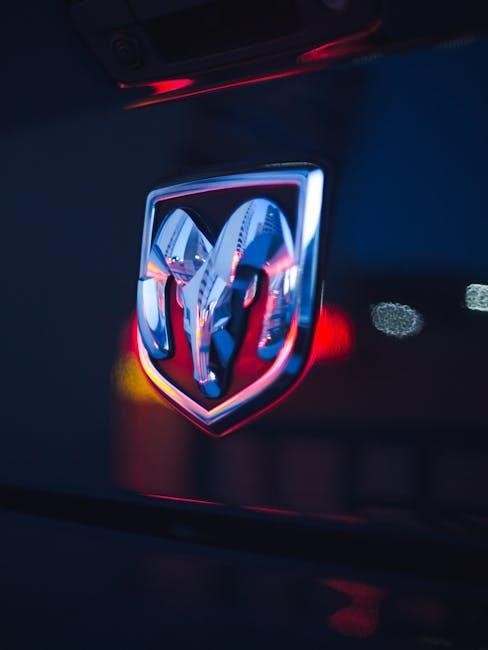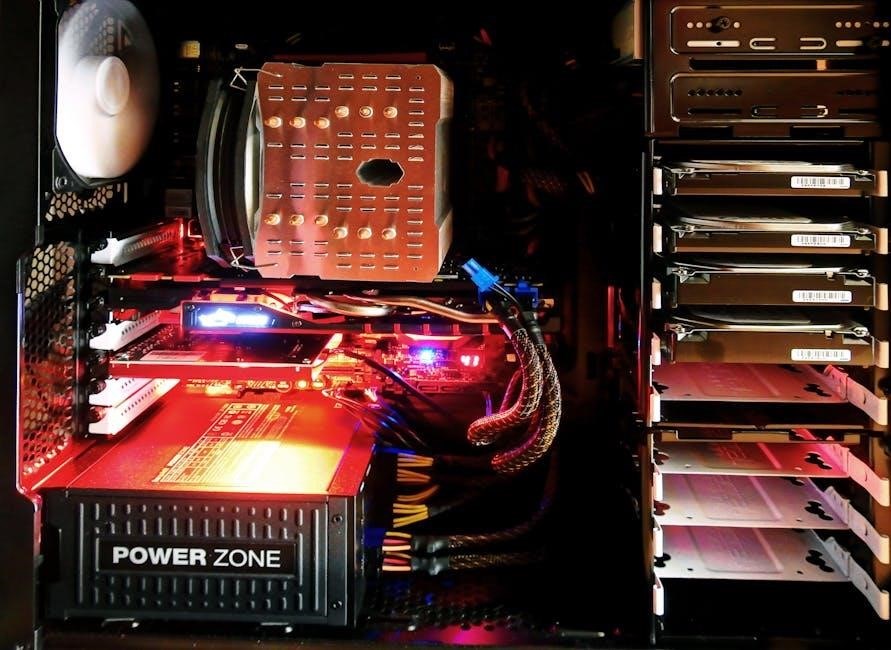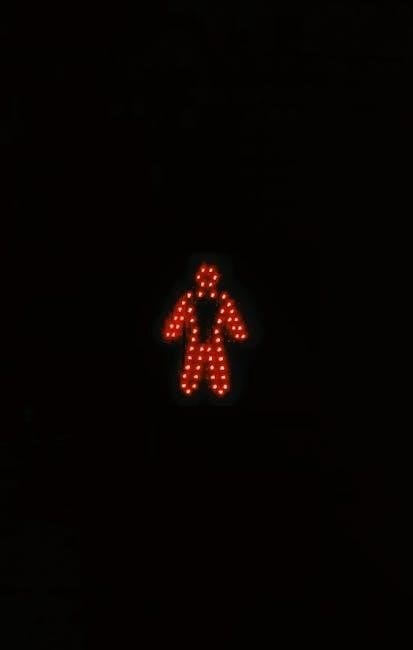Understanding Dodge Ram 1500 warning lights is crucial for safe driving and maintaining your truck. These symbols alert you to issues‚ from minor maintenance to critical system failures. This guide explains common dashboard indicators‚ their meanings‚ and the actions needed to address them‚ ensuring your vehicle runs smoothly and safely.
1.1 Overview of Dashboard Symbols
The Dodge Ram 1500 dashboard features a variety of warning lights and symbols designed to alert drivers to vehicle conditions. These indicators are color-coded to reflect severity‚ with red typically signaling critical issues‚ while yellow or amber lights indicate less urgent concerns. Green or blue symbols often represent system activations‚ such as high beams or cruise control. Each symbol corresponds to specific vehicle functions‚ such as engine performance‚ braking systems‚ or temperature levels. Understanding these dashboard symbols is essential for prompt action‚ ensuring safety and preventing potential damage to your truck.
1.2 Importance of Understanding Warning Lights
Recognizing and interpreting Dodge Ram 1500 warning lights is vital for maintaining vehicle health and safety. Ignoring these symbols can lead to costly repairs or even dangerous driving conditions. By understanding each light’s meaning‚ drivers can address issues promptly‚ preventing minor problems from escalating. This knowledge also enhances road safety‚ as it alerts you to potential system failures that could affect control or performance. Regular monitoring and quick responses ensure your truck remains reliable and secure‚ minimizing downtime and keeping you safe on the road.
Common Warning Light Symbols on Dodge Ram 1500

The Dodge Ram 1500 dashboard features various warning light symbols that indicate issues like engine problems‚ ABS malfunctions‚ or low oil pressure. Each light has a specific meaning‚ helping drivers identify and address concerns promptly to ensure safety and prevent damage.
2.1 Check Engine Light (CEL)
The Check Engine Light (CEL) is a crucial indicator on your Dodge Ram 1500 dashboard. It illuminates when the engine or emissions system detects a problem‚ such as a loose gas cap‚ faulty oxygen sensor‚ or catalytic converter issues. A steady light typically indicates a minor issue‚ while a flashing light signals a more severe problem requiring immediate attention. Ignoring the CEL can lead to increased emissions‚ reduced fuel efficiency‚ or even engine damage. Always use an OBD-II scanner to retrieve specific trouble codes and consult your owner’s manual for guidance on addressing the issue promptly.
2.2 Anti-lock Braking System (ABS) Light

The Anti-lock Braking System (ABS) Light on your Dodge Ram 1500 indicates a problem with the ABS‚ which prevents wheel lock-up during hard braking. If the light illuminates‚ it could signal issues with ABS sensors‚ the ABS module‚ or the brake system. Driving with the ABS light on can compromise safety‚ as it disables the anti-lock feature‚ potentially increasing stopping distances. Check for loose connections or damaged sensors‚ but if the issue persists‚ use a scan tool to retrieve specific codes. Consult a professional to address the problem promptly and ensure safe braking performance.
2;3 Traction Control System (TCS) Light
The Traction Control System (TCS) Light on your Dodge Ram 1500 activates when the system detects wheel slippage or engages to improve traction. This light may flash if the TCS is actively stabilizing the vehicle‚ such as on slippery surfaces. If the light stays on‚ it could indicate a malfunction in the TCS sensors‚ wiring‚ or the system itself. Check for loose connections or damaged sensors‚ and ensure tires have proper traction. If issues persist‚ use a scan tool to retrieve codes and address the problem to maintain stability and control while driving.
2.4 Electronic Stability Control (ESC) Light
The Electronic Stability Control (ESC) Light illuminates when the system is actively stabilizing your Dodge Ram 1500 or detects a malfunction. ESC helps improve vehicle stability‚ especially during sharp turns or slippery conditions‚ by adjusting engine power and braking. If the light stays on‚ it may indicate a problem with ESC sensors‚ wiring‚ or the system itself. Common causes include faulty wheel speed sensors or a malfunctioning steering angle sensor. Use a scan tool to retrieve codes for precise diagnosis. Addressing ESC issues is crucial for maintaining safe handling and preventing loss of control while driving.
2.5 Transmission Temperature Warning Light
The Transmission Temperature Warning Light activates when the Dodge Ram 1500’s transmission fluid exceeds a safe temperature. High heat can damage the transmission‚ so this light signals a critical issue. Common causes include heavy towing‚ driving in extreme heat‚ or a malfunction in the cooling system. If illuminated‚ pull over safely and allow the vehicle to cool. Check the transmission fluid level and condition‚ as low or degraded fluid can contribute to overheating. Addressing this promptly is vital to prevent costly transmission damage and ensure optimal performance. Always consult a mechanic if the issue persists.
2.6 Oil Pressure Warning Light
The Oil Pressure Warning Light is a critical indicator that appears when your Dodge Ram 1500’s engine oil pressure drops below a safe level. This light‚ often represented by an oil can symbol or the word “OIL PRESSURE‚” typically illuminates in red. Low oil pressure can damage your engine‚ so immediate attention is required. Common causes include low oil levels‚ a faulty oil pump‚ or a malfunctioning oil pressure sensor. If the light comes on‚ pull over safely and check your oil level. If it’s low‚ add the recommended oil type. If the light persists‚ avoid driving and contact a mechanic to prevent engine damage.
2.7 Battery Alert Light
The Battery Alert Light on your Dodge Ram 1500 indicates a problem with the vehicle’s charging system. This light‚ often represented by a battery symbol‚ illuminates when the battery is not charging properly or if there’s a low voltage issue. Common causes include a dead battery‚ a malfunctioning alternator‚ or loose connections. If the light comes on‚ avoid electrical load by turning off non-essential accessories and have the system checked by a professional. Ignoring this warning can lead to a dead battery or further electrical system damage‚ leaving you stranded.
2.8 Coolant Temperature Warning Light
The Coolant Temperature Warning Light on your Dodge Ram 1500 is a critical indicator that appears when the engine coolant temperature exceeds safe levels. This light‚ often depicted as a thermometer in water‚ signals potential overheating issues. Causes may include low coolant levels‚ a faulty radiator fan‚ or a malfunctioning thermostat. If illuminated‚ pull over safely‚ turn off the engine‚ and let it cool. Continuing to drive can lead to severe engine damage‚ such as cracked heads or a damaged block. Always check the coolant system and address the issue promptly to prevent costly repairs.

How to Interpret Dodge Ram 1500 Dashboard Symbols
Interpreting Dodge Ram 1500 dashboard symbols involves understanding color codes (red‚ yellow‚ green) and light patterns (flashing vs. steady). Always consult the owner’s manual for specific guidance to ensure safe and informed driving.
3.1 Color Codes: Red‚ Yellow‚ and Green
Dodge Ram 1500 dashboard symbols use color codes to indicate severity. Red signals critical issues requiring immediate attention‚ such as low oil pressure or high engine temperature. Yellow indicates caution‚ like a needed service or system malfunction. Green typically shows a feature is active‚ like high beams or cruise control. Understanding these colors helps prioritize actions‚ ensuring safety and preventing damage. Always refer to the owner’s manual for specific color meanings‚ as they may vary slightly by model year. This color system is a key part of interpreting your truck’s dashboard alerts effectively.
3.2 Flashing vs. Steady Lights: What’s the Difference?
Dodge Ram 1500 warning lights can appear as either flashing or steady. Flashing lights typically indicate urgent or active issues‚ such as a misfire or ABS malfunction‚ requiring immediate attention. Steady lights signal less critical concerns‚ like a loose gas cap or low battery. Understanding this distinction helps prioritize actions. For example‚ a flashing Check Engine Light may mean a serious problem‚ while a steady light could indicate a minor issue. Always consult the owner’s manual for specific guidance‚ as the behavior of these lights can vary slightly by model year. This distinction is key to addressing issues promptly and safely.
3.3 Consulting the Owner’s Manual
The owner’s manual is your primary resource for understanding Dodge Ram 1500 warning lights. It provides detailed explanations of each symbol‚ specific to your model year‚ ensuring accurate interpretations. The manual explains the severity of issues‚ whether a light indicates a minor problem or a critical system failure. It also offers guidance on immediate actions to take‚ such as pulling over or scheduling a service. Without consulting the manual‚ you risk misdiagnosing issues‚ which could lead to further damage or safety hazards. Always keep it handy to ensure proper understanding and maintenance of your vehicle.
Diagnostic Tools for Dodge Ram 1500
Essential tools include code readers and OBD-II scanners to identify and interpret warning light codes. These devices help diagnose issues accurately‚ enabling effective troubleshooting and repairs for your truck.
4.1 Using a Code Reader or Scan Tool
A code reader or scan tool is essential for diagnosing issues in your Dodge Ram 1500. These tools connect to the vehicle’s OBD-II system‚ retrieving Diagnostic Trouble Codes (DTCs) that explain why a warning light is illuminated. By identifying specific codes‚ you can pinpoint problems such as faulty sensors‚ system malfunctions‚ or maintenance needs. Popular options include universal OBD-II scanners and brand-specific tools like Superchips. Using these devices allows you to understand the severity of the issue‚ clear codes after repairs‚ and even monitor real-time data for better vehicle maintenance.
4.2 OBD-II Scanner Compatibility
An OBD-II scanner is a vital tool for diagnosing issues in your Dodge Ram 1500. Most modern OBD-II scanners are compatible with the Ram 1500‚ allowing you to retrieve Diagnostic Trouble Codes (DTCs) and understand the cause of a warning light. Basic scanners can read codes‚ while advanced tools offer features like real-time data monitoring and freeze frame analysis. Ensure the scanner is compatible with your vehicle’s make and model year‚ especially for newer models like the 2023 RAM 1500. Some scanners‚ such as those from Superchips‚ are tailored for Dodge vehicles‚ providing precise diagnostics and troubleshooting capabilities.
4.3 DIY Troubleshooting Tips
Before visiting a mechanic‚ try these DIY troubleshooting tips for your Dodge Ram 1500. Start by using a code reader to identify the issue. Loose gas caps or faulty sensors often trigger warning lights like P0455. Check battery connections for corrosion and ensure all fluids‚ such as coolant and oil‚ are at proper levels. For minor issues‚ resetting the system may resolve the problem. Always consult your owner’s manual for guidance specific to your model year. These simple steps can save time and money before seeking professional help.

Common Diagnostic Trouble Codes (DTCs)
DTCs like P0171 (System Too Lean) and P0300 (Random Cylinder Misfire) indicate engine issues. P0455 points to evaporative system leaks. These codes help diagnose and address problems efficiently.

5.1 P0171: System Too Lean

The P0171 code indicates that your Dodge Ram 1500’s engine is running too lean‚ meaning there’s too much air relative to fuel. This can be caused by a vacuum leak‚ faulty oxygen sensor‚ or mass airflow sensor issues. A lean condition can lead to poor performance‚ reduced fuel efficiency‚ and potential engine damage. To diagnose‚ use a scan tool to check for related codes and inspect the intake system for leaks. Cleaning or replacing faulty sensors may resolve the issue. If persistent‚ consult a mechanic to avoid further complications.
5.2 P0300: Random Cylinder Misfire
The P0300 code indicates a random cylinder misfire in your Dodge Ram 1500’s engine. This occurs when one or more cylinders fail to fire properly‚ often due to issues like faulty spark plugs‚ ignition coil problems‚ or a lean fuel condition. Symptoms include a flashing Check Engine Light‚ rough engine operation‚ and reduced power. Ignoring this can lead to decreased fuel efficiency and potential damage to the catalytic converter. To diagnose‚ use a scan tool to identify the affected cylinder and check for related codes. Inspect spark plugs‚ ignition coils‚ and fuel injectors for faults. If unresolved‚ consult a mechanic to prevent further engine damage.
5.3 P0455: Evaporative Emission Control System Leak
The P0455 code indicates a small leak in the Evaporative Emission Control (EVAP) system of your Dodge Ram 1500. This system prevents fuel vapors from escaping into the atmosphere. Common causes include a loose or damaged gas cap‚ cracked hoses‚ or faulty valves. Symptoms may include the Check Engine Light illuminating and a noticeable fuel smell. To diagnose‚ use a scan tool to confirm the code and inspect the system for visible damage. A loose gas cap is often an easy fix‚ but persistent issues may require professional attention to repair or replace faulty components and ensure emissions compliance.

Maintenance and Repair Tips
Regular maintenance is key to preventing issues. Check fluids‚ filters‚ and belts routinely. Address warning lights promptly and consult your owner’s manual for guidance. Visit a mechanic if problems persist.
6.1 Resetting Warning Lights After Repairs
After addressing the issue‚ reset the warning lights using an OBD-II scanner or code reader. Turn the ignition on‚ connect the tool‚ and clear the codes. Some systems may require turning the ignition off and on again or restarting the engine. Ensure all repairs are verified before resetting. If the light remains on‚ further diagnosis is needed. Always refer to your owner’s manual for specific instructions. Properly resetting lights ensures accurate monitoring of your Ram 1500’s systems and prevents misleading alerts.
6.2 Regular Maintenance to Prevent Issues

Regular maintenance is key to preventing issues that trigger warning lights on your Ram 1500. Routine oil changes‚ tire pressure checks‚ and coolant level inspections help avoid system failures. Addressing worn brakes‚ faulty sensors‚ and loose connections can prevent ABS‚ TCS‚ and ESC lights from illuminating. Stay on top of scheduled services outlined in your owner’s manual. Neglecting maintenance can lead to costly repairs and safety risks. By keeping your truck well-maintained‚ you reduce the likelihood of unexpected warning lights and ensure reliable performance on the road.
6.3 When to Visit a Professional Mechanic
If a warning light persists or you’re unsure of its meaning‚ consult a professional mechanic. They have the tools‚ like OBD-II scanners‚ to diagnose issues accurately. For critical systems like the transmission or engine‚ don’t delay—immediate attention can prevent severe damage. Mechanics can also reset warning lights after repairs and ensure your Ram 1500 is road-safe. Regular check-ups and addressing minor issues early can save you from costly repairs down the road. Trusting a professional ensures your truck runs smoothly and safely.

Model-Specific Variations
Different Ram 1500 model years and trims may have unique warning light symbols and interpretations. Always consult your specific owner’s manual for accurate information.
7.1 Differences in Warning Lights Across Model Years
Warning lights on the Dodge Ram 1500 vary slightly across model years‚ with older models having fewer symbols compared to newer ones. For instance‚ the 2023 Ram 1500 features advanced systems like adaptive cruise control‚ which introduces unique indicators. Color codes also play a role‚ with red indicating critical issues and yellow for less urgent matters. Always refer to your vehicle’s specific owner’s manual for accurate interpretations‚ as variations exist even within the same model line. Staying informed ensures safe and efficient driving‚ regardless of your Ram 1500’s model year.
7.2 Unique Symbols for 2023 RAM 1500
The 2023 RAM 1500 features unique warning symbols tailored to its advanced systems. For example‚ the adaptive cruise control and lane-keeping assist indicators are exclusive to this model year. These symbols alert drivers to system activations or issues specific to its cutting-edge technology. Additionally‚ the hybrid powertrain models include unique lights for battery and electric motor status. Always consult the owner’s manual for precise interpretations‚ as these symbols differ from earlier models. Understanding these indicators ensures optimal performance and safety in the latest RAM 1500;
